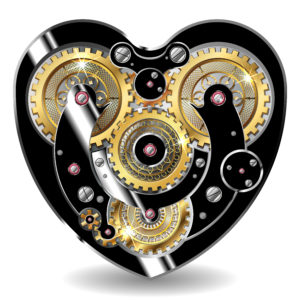Atrial fibrillation2 (A-tre-al fi-bri-LA-shun), or AF, is the most common type of arrhythmia (ah-RITH-me-ah). An arrhythmia is a problem with the rate or rhythm of the heartbeat. During an arrhythmia, the heart can beat too fast, too slow, or with an irregular rhythm.
Subscribe to our Newsletter
AF occurs if rapid, disorganized electrical signals cause the heart’s two upper chambers—called the atria (AY-tree-uh)—to fibrillate. The term “fibrillate” means to contract very fast and irregularly.
Related Articles
In AF, blood pools in the atria. It isn’t pumped completely into the heart’s two lower chambers, called the ventricles (VEN-trih-kuls). As a result, the heart’s upper and lower chambers don’t work together as they should.
People who have AF may not feel symptoms. However, even when AF isn’t noticed, it can increase the risk of stroke. In some people, AF can cause chest pain or heart failure, especially if the heart rhythm is very rapid.

AF may happen rarely or every now and then, or it may become an ongoing or long-term heart problem that lasts for years.
AFib Facts3
- An estimated 2.7–6.1 million people in the United States have AFib. With the aging of the U.S. population, this number is expected to increase.
- Approximately 2% of people younger than age 65 have AFib, while about 9% of people aged 65 years or older have AFib.
- African Americans are less likely than those of European descent to have AFib.
- Because AFib cases increase with age and women generally live longer than men, more women than men experience AFib.
Understanding the Heart’s Electrical System
To understand AF, it helps to understand the heart’s internal electrical system. The heart’s electrical system controls the rate and rhythm of the heartbeat.

With each heartbeat, an electrical signal spreads from the top of the heart to the bottom. As the signal travels, it causes the heart to contract and pump blood.
Each electrical signal begins in a group of cells called the sinus node or sinoatrial (SA) node. The SA node is located in the right atrium. In a healthy adult heart at rest, the SA node sends an electrical signal to begin a new heartbeat 60 to 100 times a minute. (This rate may be slower in very fit athletes.)
From the SA node, the electrical signal travels through the right and left atria. It causes the atria to contract and pump blood into the ventricles.
The electrical signal then moves down to a group of cells called the atrioventricular (AV) node, located between the atria and the ventricles. Here, the signal slows down slightly, allowing the ventricles time to finish filling with blood.
The electrical signal then leaves the AV node and travels to the ventricles. It causes the ventricles to contract and pump blood to the lungs and the rest of the body. The ventricles then relax, and the heartbeat process starts all over again in the SA node.
For more information about the heart’s electrical system and detailed animations, go to the Diseases and Conditions Index How the Heart Works article.
Understanding the Electrical Problem in Atrial Fibrillation
In AF, the heart’s electrical signals don’t begin in the SA node. Instead, they begin in another part of the atria or in the nearby pulmonary veins. The signals don’t travel normally. They may spread throughout the atria in a rapid, disorganized way. This can cause the atria to fibrillate.

Thus, the atria and ventricles no longer beat in a coordinated way. This creates a fast and irregular heart rhythm. In AF, the ventricles may beat 100 to 175 times a minute, in contrast to the normal rate of 60 to 100 beats a minute.
If this happens, blood isn’t pumped into the ventricles as well as it should be. Also, the amount of blood pumped out of the ventricles to the body is based on the random atrial beats. The body may get rapid, small amounts of blood and occasional larger amounts of blood. The amount will depend on how much blood has flowed from the atria to the ventricles with each beat.
Most of the symptoms of AF are related to how fast the heart is beating. If medicines or age slow the heart rate, the symptoms are minimized. AF may be brief, with symptoms that come and go and end on their own. Or, the condition may be ongoing and require treatment. Sometimes AF is permanent, and medicines or other treatments can’t restore a normal heart rhythm.
Risk Factors For Arrhythmias and Heart Disease
The following conditions can increase the chance of developing arrhythmias, or abnormal heart rhythms according to the Heart Rhythm Society4:
- Coronary artery disease (blockage in the arteries/pipes of the heart)
- High Blood Pressure
- Diabetes
- Smoking
- High cholesterol
- Obesity/overweight
- A high-fat diet
- Excessive use of alcohol (more than 2 drinks per day)
- Drug abuse
- Stress
- A family history of heart disease
- Advancing age (getting older)
- Sleep apnea
- Certain over-the-counter and prescription medications, dietary supplements, and herbal remedies.

Outlook
People who have AF can live normal, active lives. For some people, treatment can restore normal heart rhythms.
For people who have permanent AF, treatment can help control symptoms and prevent complications. Treatment may include medicines, medical procedures, and lifestyle changes.Jay Harold will write about some of the treatment options in a future post.
Enjoyed this post? Share it and read more here. Jay Harold has put together a Resource page that you may find useful when trying to improve your health and wealth. Please take this advice from Muhammad Ali and give back to others. “Service to others is the rent you pay for your room here on earth.”
Bibliography
- https://www.cdc.gov/nchs/data/nvsr/nvsr66/nvsr66_05.pdf (Page 12)
- https://www.nhlbi.nih.gov/health-topics/atrial-fibrillation
- https://www.cdc.gov/dhdsp/data_statistics/fact_sheets/fs_atrial_fibrillation.htm
- https://www.hrsonline.org/Patient-Resources/Risk-Factors-Prevention




